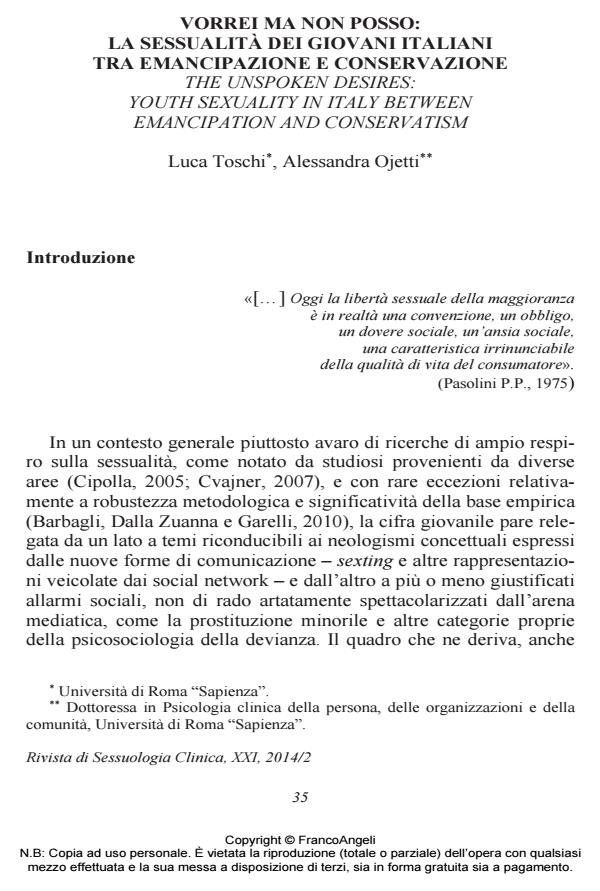The unspoken desires: youth sexuality in italy between emancipation and conservatism
Journal title RIVISTA DI SESSUOLOGIA CLINICA
Author/s Luca Toschi, Alessandra Ojetti
Publishing Year 2014 Issue 2014/2 Language Italian
Pages 21 P. 35-55 File size 95 KB
DOI 10.3280/RSC2014-002002
DOI is like a bar code for intellectual property: to have more infomation
click here
Below, you can see the article first page
If you want to buy this article in PDF format, you can do it, following the instructions to buy download credits

FrancoAngeli is member of Publishers International Linking Association, Inc (PILA), a not-for-profit association which run the CrossRef service enabling links to and from online scholarly content.
The postmodern representation of youth sexuality tells of new generations in appearance suited to an unconventional and disengaged relationality, exposed to the risks of occasional experimentation. In fact, against a disclosure of common sense too often tainted by media overexposure of private behavior - which not rarely indulges even the scientific debate - young Italians experiences of intimacy occur prevalently traditionalist and sensitive to old and new forms of social control. The survey aims to resize the libertarian mythology built around the postmodern use of intimate relationships by new generations, analyzing emerging patterns in terms of attitudes, behaviors and specific sexual practices. Were interviewed 258 subjects (114 M, 144 F) enrolled on psychological area courses (mean age 24.3 years, SD 3.09). The issues investigated are: personal data and family of origin; religion and leisure; school, college and friendships; emotions and relationships; opinions and attitudes; pleasure, practice and experimentation. Our results confirm lack of association between representations (individual judgments) and actions (relational biography), a persistent gender differentiation - especially in terms of ethical reprobation and expectations - and strategies in testing sexuality that are substantially filtered by traditional order and legitimate social roles (family, affective couple).
Keywords: Youth, relationality, affectivity, sexuality, social patterns, sexual practices.
- Buzzi C. (1998). Giovani, affettività e sessualità. Bologna: Il Mulino.
- Cipolla C., (2005). La sessualità come obbligo all’alterità. Milano: FrancoAngeli.
- Crouter A.C., Booth A., eds. (2006). Romance and Sex in Adolescence and Emerging Adulthood. New Jersey: Erlbaum.
- Cvajner M. (2007). Dopo Kinsey. Sviluppo, limiti e prospettive degli studi empirici sulla sessualità umana. Polis, 2: 295-321. DOI: 10.1424/24971
- Barbagli M., Dalla Zuanna G., Garelli F. (2010). La sessualità degli italiani. Bologna: Il Mulino.
- Bauman Z. (2001). On Postmodern Uses of Sex. In: Bauman Z. (eds), The Individual Society. Cambridge: Polity Press (trad. it.: Gli usi postmoderni del sesso. Bologna: Il Mulino, 2013).
- Bauman Z. (2003). Liquid Love: On the Frailty of Humans Bond. Cambridge: Polity Press (trad. it.: Amore Liquido. Sulla fragilità dei legami affettivi. Bari: Laterza, 2006).
- Baumeister R.F., eds. (2001). Social Psychology and human sexuality. Philadelphia: Taylor & Francio.
- D’Amico R. (2006). Le relazioni di coppia. Potere, dipendenza, autonomia. Bari: Laterza.
- Dalla Zuanna G., Crisafulli C., eds. (2004). Sexual Behaviour of Italian Students. Pubblicazione effettuata con i fondi di ricerca MIUR ex 60% e con un contributo straordinario del Consiglio di Amministrazione dell’Università degli studi di Messina. Disponibile su richiesta a: Dipartimento di Statistica – Università di Messina.
- DeLamater J.D., Hyde J.S. (1998). Essentialism vs. Social Constructionism in the Study of Human Sexuality. Journal of Sex Research, 35: 10-18. DOI: 10.1080/00224499809551913
- Easton D., Hardy J. (1997). The Ethical Slut. A Guide to Infinite Sexual Possibilities. New York: Greenery Press (trad. it.: La zoccola etica. Guida al poliamore, alle relazioni aperte e altre avventure. Bologna: Odoya, 2014). Fabris G., Davis R. (1978). Il mito del sesso: rapporto sul comportamento sessuale degli italiani. Milano: Mondadori.
- Gaetani G. (2010). Elogio del tradimento. Conquista, tradisci, nega!. Firenze: Vallecchi.
- Gagnon J.H., Simon W. (1973). Sexual Conduct: The Social Sources of Human Sexuality. Chicago: Aldine.
- Garelli F. (2000). I giovani, il sesso, l’amore. Bologna: Il Mulino.
- Laumann E.O., Gagnon J.H., Michael R.T., Michaels S. (1994). The Social Organization of Sexuality: Sexual Practices in the United States. Chicago: University of Chicago Press.
- Lolli E. (1996). La sessualità secondo una strategia euristica transdisciplinare. In: Cipolla C. ed., Sul letto di Procuste. Introduzione alla sociologia della sessualità. Milano: FrancoAngeli.
- Operto S. (2011). L’osservazione indiscreta. Uno sguardo sulle ricerche sociologiche riguardanti la sessualità e le sue trasformazioni. In: Inghilleri M., Ruspini
- E. ed., Sessualità narrate. Esperienze di intimità a confronto. Milano: FrancoAngeli.
- Sabatini S. (1988). L’eros in Italia. Il comportamento sessuale degli italiani. Milano: U. Mursia editore.
- Toschi L. (2009a). Sociologia e sessualità. Modelli relazionali giovanili e ricerca empirica. Roma: Bonanno Editore.
- Toschi L. (2009b). Le relazioni tra i sessi nella transizione all’adultità: declinazioni dell’intimità e ricerca empirica. In: Rauty R., ed. La ricerca giovane. Percorsi di analisi della condizione giovanile. Lecce: Kurumuny.
- Turnaturi G. (1994). Flirt Seduzione Amore. Simmel e le emozioni. Milano: Edizioni Anabasi.
- Vaccaro C.M., ed. (2003). I comportamenti sessuali degli italiani. Falsi miti e nuove normalità. Milano: FrancoAngeli.
- Valcarenghi M. (2009). L’amore difficile. Relazioni al tempo dell’insicurezza. Milano: Bruno Mondadori.
Luca Toschi, Alessandra Ojetti, Vorrei ma non posso: la sessualità dei giovani italiani tra emancipazione e conservazione in "RIVISTA DI SESSUOLOGIA CLINICA" 2/2014, pp 35-55, DOI: 10.3280/RSC2014-002002